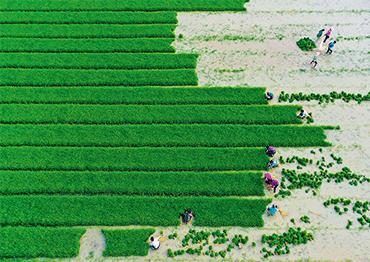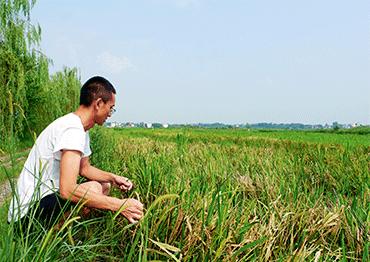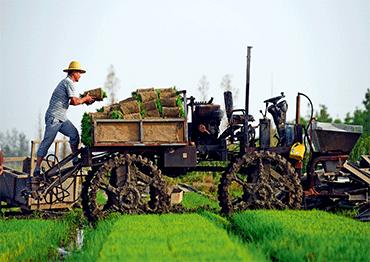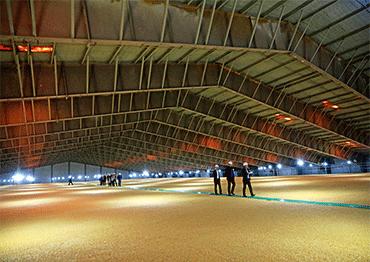Several interviewed experts said that the key to China’s food security is ensuring that farmers receive good incomes. A real obstacle to grain production is the high cost of farming in relation to the low income of farmers.
Statistics from the Qishengyuan Agriculture Biology Science Company in Jiangxi Province show that it costs 760 yuan (US$112) to grow one mu (666.7 square meters) of rice. This includes the seedlings, plowing, pesticides and fertilizers, harvesting and other expenses. According to the market price for rice, a farmer can earn 1,350 yuan (US$200) per mu, leaving a profit of just 590 yuan (US$87).
Han Fuling, a professor at the School of Finance of the Central University of Finance and Economics, posted on his Weibo account the income from planting one mu of wheat in Xinzhuang Village, Wen’an County, Hebei Province as 243 yuan (US$36). It is not known how much land each farmer has on average.
According to statistics released by Tianfeng Securities Research Institute in 2016, China was the world’s top agricultural producer, but per capita agricultural added value was the second-lowest. Compared with the US, production costs for staple crops such as rice, wheat, corn, soybeans and cotton are higher in China. In particular, it costs three times as much to produce wheat in China as in the US.
Mao Xuefeng, a professor at the School of Agriculture and Rural Development at the Renmin University of China, told NewsChina that rising land and labor costs are key factors driving food production costs in China. In the past decade, the cost per unit of food production has risen significantly higher than in the US and Brazil, and the cost difference has gradually widened. Labor and land costs are high and limited mechanization is a central issue.
Starting in 2004, China rolled out a series of agricultural subsidies for seeds and agricultural machinery, tools and other materials to boost incomes and production. In 2016, China implemented a “three subsidies” policy reform for agriculture, combining the previous direct grain supplement, comprehensive agricultural subsidies and subsidies for improved crop varieties into cultivated land protection subsidies.
In reality, the three subsidies policy is not very attractive to farmers, and many middle-aged and young people are unwilling to work the land. Dang Guoying, a researcher at the Institute of Rural Development at CASS, told NewsChina that China’s agricultural subsidy policy needs revision. In his view, while it would be less cost-effective for farmers to farm their land without subsidies, these could be reduced if there was a shift in focus toward reducing the cost of farming. Dang’s research found that the price of imported grain from the US is 30 percent cheaper than domestic grain. If the price of domestic grain were 30 percent lower, most Chinese farmers would choose not to farm anymore. “We must consolidate farms to lower costs and promote modern agriculture,” Dang said.
To tackle the high cost of grain farming, China established a minimum purchase price policy in 2004. In the previous decade, China had implemented a 10-year protected price acquisition policy. Their aim was to promote grain price marketization. But these policies did not work as hoped.
Zhang Xiaoshan said that the policy of a minimum purchase price and a temporary storage price does not fluctuate with the changing cost of grain planting, thus distorting the market. The purchase price of grain increases annually, which deviated from the market law and results in the phenomenon of storing domestic grain and selling imported grain.
Mao Xuefeng believes that the minimum grain purchase price policy led to the expansion of the price differential at home and abroad, causing a series of problems, and it forced the country to promote price reform. In 2017, China embarked on deepening supply-side structural reform of grain, indicating the purchase price for rice and wheat stock would be decided by the market.
“Separation of price-setting and subsidies is the direction for market reform of grain production,” Zhang Xiaoshan said. “The market should decide prices.”
“When considering food security, we have paid too much attention to stockpiles. In fact, food security is a systemic issue, and from a long-term perspective, related to food-producing capacity rather than mere stockpiles,” Chen Ming, an executive researcher at the Institute of Political Science at CASS, wrote in an article published in The Beijing News in April, which emphasized securing farmland and incentives for farmers is more important than stockpiling grain.

 Old Version
Old Version




